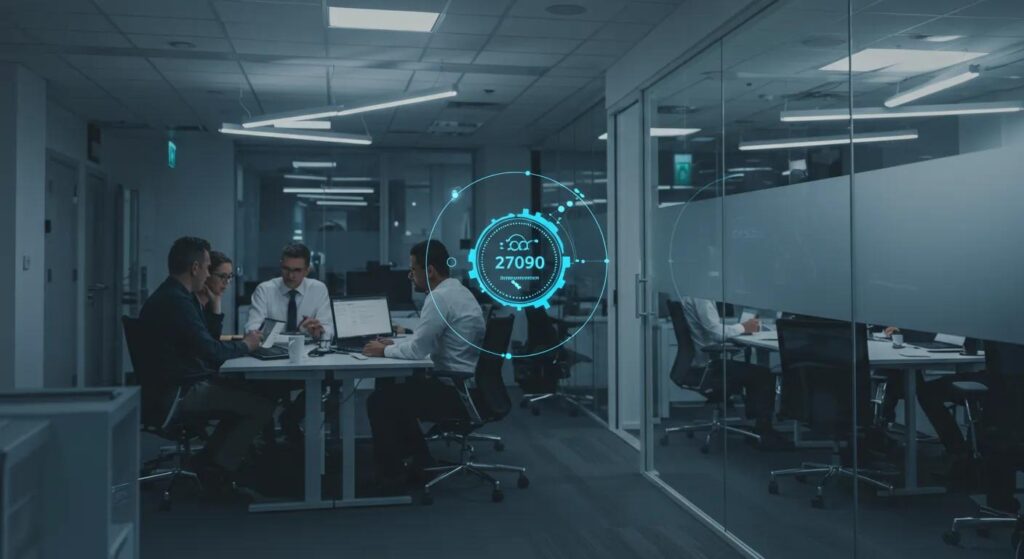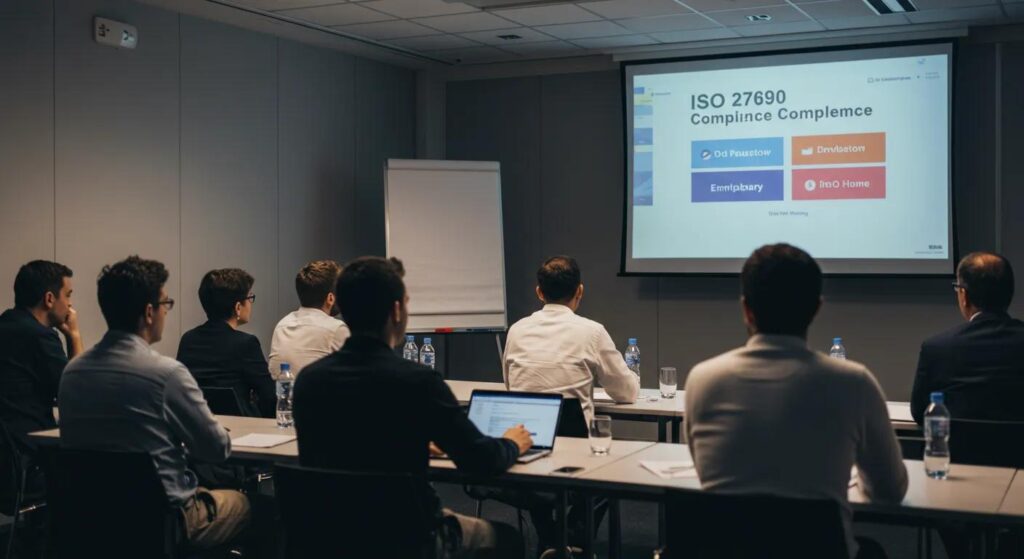ISO 27090 Standard Guidelines for Effective Management

ISO 27090 Standard: A Comprehensive Guide
How secure is your organization‘s information management? The ISO 27090 standard offers a framework designed to enhance data protection strategies. This comprehensive guide will cover the purpose of ISO 27090, its specific requirements, and how it interrelates with other standards. Readers will gain valuable insights into implementing this standard effectively, addressing the need for robust information security measures in today’s evolving digital landscape. This resource will help organizations recognize the importance of ISO 27090 for maintaining client trust and regulatory compliance.
Key Takeaways
- ISO 27090 enhances information security through structured knowledge management and ethical accountability
- Organizations benefit from improving data security practices by adopting the ISO 27090 standard
- Compliance with ISO 27090 requires systematic risk assessments and incident management protocols
- The standard promotes interoperability, ensuring secure information exchange among systems
- Integrating ISO 27090 with other standards strengthens overall security and compliance efforts
Understanding the ISO 27090 Standard and Its Purpose

The iso 27090 standard focuses on enhancing information security through structured knowledge management, emphasizing ethics and accountability. It serves as an essential international standard that guides organizations in establishing effective security practices. This section will outline the key objectives and principles of ISO 27090, as well as provide an overview of its framework and model, illustrating its importance in information security management.
Key Objectives and Principles of the ISO 27090 Standard
The ISO 27090 standard aims to enhance information security management by establishing systematic practices that prioritize data retention and integrity. One of its primary objectives is to ensure ethical handling of information through accountability frameworks that adhere to guidelines set forth by entities like the National Cyber Security Centre. This standard also addresses emerging challenges in AI safety, ensuring that machine learning systems are developed and maintained with robust security measures to protect sensitive data from potential vulnerabilities.
Importance of ISO 27090 in Information Security Management
The ISO 27090 standard plays a crucial role in advancing information security management, especially within the European Union‘s regulatory framework. By addressing vulnerabilities that arise from innovations in network virtualization, this standard guides organizations in building a resilient security ecosystem. It empowers businesses to adopt preventive measures against potential threats while promoting ethical practices in information handling, ultimately ensuring the integrity of their data management strategies.
Overview of the ISO 27090 Framework and Model
The ISO 27090 framework provides a structured approach to enhancing information security by integrating principles of misinformation prevention, privacy engineering, and trustworthy AI. This model outlines systematic practices and documentation processes that organizations can adopt to ensure safety in their data management strategies. One practical application of the framework is its ability to mitigate risks associated with managing sensitive information, thereby fostering a culture of trustworthiness and accountability within an organization.
- Introduction to the ISO 27090 Standard and its Purpose
- Key Objectives and Principles of the ISO 27090 Standard
- Importance of ISO 27090 in Information Security Management
- Overview of the ISO 27090 Framework and Model
The ISO 27090 standard lays a strong foundation for security, guiding organizations toward better protection. Now, let’s explore how this standard takes shape within companies and the real benefits it brings.
How the ISO 27090 Standard Applies to Organizations

Organizations across various sectors, including telecommunications, can achieve significant benefits from adopting the ISO 27090 standard, particularly in enhancing data security practices. Key areas covered include implementation steps for attaining ISO 27090 compliance, understanding the challenges faced during implementation, and the impacts of generative artificial intelligence on data management. Each topic will provide practical insights into effectively navigating the ISO 27090 landscape while ensuring robust information security measures are in place.
Organizations That Benefit From Adopting ISO 27090
Organizations that adopt the ISO 27090 standard can significantly enhance their information security, particularly in sectors such as cloud computing and telecommunications. By aligning with this specification, businesses can improve their enterprise risk management frameworks, mitigating risks associated with data breaches and reputational damage. Furthermore, the standard promotes interoperability between systems, ensuring that organizations can securely exchange information while maintaining compliance with emerging regulatory requirements.
| Organization Type | Benefits of ISO 27090 |
|---|---|
| Cloud Computing Providers | Improved data security and compliance assurance. |
| Telecommunications Companies | Enhanced interoperability and risk management capabilities. |
| Financial Institutions | Reduction in reputational damage and data leakage risks. |
| Healthcare Organizations | Strengthened protection for sensitive patient information. |
Implementation Steps for Attaining ISO 27090 Compliance
To attain ISO 27090 compliance, organizations should begin by conducting a comprehensive assessment of their current information security practices. This initial simulation allows for the identification and understanding of potential vulnerabilities and gaps in existing systems, ensuring that a solid foundation is built for compliance. Implementing the principles of privacy by design is essential, enabling organizations to integrate data protection measures into their processes and vocabulary from the outset, thus fostering a culture of knowledge that prioritizes security.
| Implementation Steps | Description |
|---|---|
| Conduct a Risk Assessment | Identify vulnerabilities and gaps in current security practices. |
| Integrate Privacy by Design | Embed data protection into organizational processes from the start. |
| Develop a Security Framework | Create structured protocols and procedures for information security management. |
| Train Staff | Ensure all employees understand their role in maintaining compliance. |
| Monitor and Review | Regularly assess security measures and update them as necessary. |
Challenges Faced During ISO 27090 Implementation
Implementing the ISO 27090 standard can present several challenges for organizations. Many businesses struggle to adapt their existing systems to comply with the new requirements, especially when integrating open source solutions or addressing big data issues, which often complicate data protection efforts. Furthermore, organizations must ensure that their practices align with standards such as the OWASP AI Exchange, which emphasizes ethical considerations in AI deployment, thereby enhancing their overall security posture within society.
- Integration of existing systems with ISO 27090 requirements
- Adapting to challenges posed by big data
- Alignment with OWASP AI Exchange considerations
- Ensuring compliance with ethical standards in society
Understanding ISO 27090 is essential for any organization aiming to secure its information. Next, a closer look at the specific requirements will reveal how to effectively implement this standard.
Detailed Breakdown of ISO 27090 Requirements

This section outlines the core components of the ISO 27090 standard, highlighting the focus areas that address critical infrastructure and smart city initiatives. It also covers the criteria used for evaluating compliance with the standard, ensuring organizations are equipped to avoid potential lawsuits and uphold necessary accreditation. Each aspect provides valuable insights into enhancing information security practices.
Core Components of the ISO 27090 Standard
The core components of the ISO 27090 standard focus on establishing a robust architecture that enhances information security across various sectors. By integrating frameworks recommended by influential entities like the National Institute of Standards and Technology, organizations can foster trust in their security measures while addressing threats like ransomware effectively. Key elements include risk management practices, clear guidelines for wireless communications, and the development of resilient systems that support safe data transactions and safeguard sensitive information.
| Core Components | Description |
|---|---|
| Risk Management | Identifying and mitigating potential vulnerabilities within information systems. |
| Architecture Guidelines | Creating secure frameworks that support data protection and compliance. |
| Trust Enhancement | Building user confidence through transparent security practices. |
| Wireless Security Measures | Implementing protocols to protect data transmitted over wireless networks. |
| Ransomware Prevention | Strategies to defend against ransomware attacks and ensure continuity. |
Focus Areas Addressed by the Standard
The ISO 27090 standard addresses several critical focus areas essential for enhancing information security and compliance. First, it emphasizes the importance of data quality, ensuring that organizations maintain high standards for accuracy and reliability in their information management systems. Additionally, the standard outlines strategies for effective authentication processes, which are vital for preventing unauthorized access. It also incorporates elements that address adversarial machine learning, recognizing the need for security measures against threats in modern IT environments. Alongside these, considerations for functional safety are vital, particularly for systems where safety and security intertwine, and effective IT service management practices support seamless operational continuity:
| Focus Area | Description |
|---|---|
| Data Quality | Maintaining high standards for accuracy and reliability in information management. |
| Authentication | Implementing effective processes to prevent unauthorized access to sensitive information. |
| Adversarial Machine Learning | Addressing security measures against threats related to machine learning systems. |
| Functional Safety | Ensuring safety and security in systems where they are closely related. |
| IT Service Management | Supporting seamless operational continuity through effective management practices. |
Criteria for Evaluating Compliance With ISO 27090
Evaluating compliance with the ISO 27090 standard involves a systematic approach that focuses on risk management, leadership engagement, and the protection of personal data, all while adhering to principles of standardization. Organizations should implement thorough audits that assess the effectiveness of their machine learning systems and their capacity to mitigate risks related to data security. Adopting a proactive leadership strategy ensures that compliance processes are integrated into the organization‘s culture, thereby fostering accountability and a commitment to ongoing improvement in data handling practices:
- Assessing risk management strategies
- Engaging leadership to promote compliance
- Protecting personal data within systems
- Standardizing practices across organizational processes
- Evaluating machine learning system effectiveness
ISO 27090 sets the stage for effective data security, but its influence stretches beyond its own guidelines. Exploring its connections with other standards reveals how it fits into the larger picture of information protection.
ISO 27090 and Its Relationship With Other Standards

ISO 27090 establishes significant connections with ISO 27001, creating a cohesive concept for information security management. The subsequent comparative analysis will highlight how ISO 27090 aligns with similar frameworks while contextualizing its relevance in data science, particularly regarding algorithmic bias and differential privacy. Understanding these relationships underscores the value of implementing ISO 27090 alongside other standards to bolster organizational security and compliance efforts.
Connections Between ISO 27090 and ISO 27001
The ISO 27090 standard is closely related to ISO 27001, forming a comprehensive framework that enhances information security management, particularly in supply chain management. Both standards emphasize the importance of risk management to safeguard against data breaches, ensuring that organizations in the information and communications technology sector adopt robust practices for certification. By aligning with ISO 27001, organizations can implement systematic processes that not only strengthen their overall security posture but also facilitate compliance with international norms in information security.
Comparative Analysis of ISO 27090 With Similar Frameworks
The ISO 27090 standard presents a robust framework for organizations seeking to enhance their information security, particularly focusing on supply chain security and access control measures. In comparison with similar frameworks, such as ISO 27001, ISO 27090 emphasizes the importance of intelligence-driven riskmitigation strategies to protect sensitive information. By integrating effective practices from both standards, organizations can create a comprehensive approach to security that addresses vulnerabilities and strengthens their overall resilience against data breaches.
The Significance of Using ISO 27090 Alongside Other Standards
Integrating ISO 27090 with other standards, such as ISO 31000, significantly enhances an organization‘s risk management framework by promoting transparency and a systematic approach to data management. This collaboration not only streamlines verification and validation processes but also ensures a comprehensive assessment of potential vulnerabilities. By aligning with multiple standards, organizations are better equipped to implement robust security measures, thereby fostering an environment where ethical practices and strict compliance are prioritized, ultimately leading to improved overall security posture.
ISO 27090 has carved its place among the essential standards, shaping how organizations approach information security. As the landscape changes, new trends and developments in this standard promise to drive further enhancements in data protection strategies.
Future Trends and Developments in ISO 27090

Emerging technologies such as automation and explainable artificial intelligence are expected to significantly influence the ISO 27090 standard, leading to new classification benchmarks for information security. Anticipated revisions to the standard will address evolving security challenges, while predictions suggest increased adoption across various industries, fostering enhanced asset management and data protection strategies.
Emerging Technologies and Their Impact on ISO 27090
Emerging technologies, including advanced encryption methods and robust firewall solutions, are poised to reshape the landscape of the ISO 27090 standard. As organizations increasingly rely on these technologies to comply with General Data Protection Regulation (GDPR) requirements and to safeguard their supply chain operations, the standard will evolve to incorporate more stringent security measures. Furthermore, aligning with OWASP guidelines will become essential, ensuring that organizations not only enhance their information security posture but also remain agile in the face of emerging threats and vulnerabilities.
Anticipated Revisions and Updates to the Standard
Anticipated revisions to the ISO 27090 standard are expected to focus on key areas such as risk assessment and sustainability, reflecting the evolving landscape of information security. With the increasing prevalence of the Internet of Things (IoT), updates will likely emphasize confidentiality and protective measures for interconnected devices. Additionally, collaboration with organizations like the International Electrotechnical Commission will ensure that these revisions align with global standards, fostering enhanced security protocols that address contemporary challenges in data management.
Predictions for ISO 27090 Adoption in Various Industries
As industries continue to evolve, the adoption of the ISO 27090 standard is expected to gain traction across various sectors, particularly in fintech and infrastructure. Organizations will increasingly recognize the importance of implementing data protection algorithms that enhance security and compliance measures. The integration of these standards will serve as a vital gateway for companies to not only safeguard sensitive information but also to demonstrate their commitment to ethical practices and robust data management.
- Increased adoption in fintech for data security.
- Infrastructure improvements through standardized security practices.
- Enhanced use of algorithms to streamline data protection.
- Organizations recognizing ISO 27090 as a necessary guideline.
- Establishment of a secure gateway for data management compliance.
The future of ISO 27090 is bright, filled with possibilities that can reshape security frameworks. As this standard gains traction, real-world examples show how businesses are turning theory into practice with impressive results.
Practical Applications and Case Studies of ISO 27090

The subsequent sections will highlight real-world examples showcasing the successful implementation of ISO 27090, emphasizing methodologies that bolster information security policies against cybercrime. Insights into lessons learned from organizations that adopted the standard will provide valuable knowledge, while best practices for maintaining compliance, including effective use of cryptography, will underscore the relevance of the European Committee for Standardization‘s guidelines.
Real-World Examples of ISO 27090 Implementation Success
Real-world examples of ISO 27090 implementation highlight its effectiveness in enhancing application security across various sectors. For instance, organizations adopting the guideline have utilized a structured taxonomy to manage vulnerabilities related to malware, resulting in improved riskmitigation strategies. Furthermore, collaborations with European Telecommunications Standards Institute (ETSI) have provided a navigator for organizations to align their security practices with evolving regulatory requirements, demonstrating the practical benefits of this standard in fostering resilience against emerging threats.
Lessons Learned From Organizations That Adopted the Standard
Organizations that adopted the ISO 27090 standard have gained valuable insights regarding governance and regulatory compliance. Case studies indicate that effective database management and regular audits significantly enhance the organization’s ability to mitigate risk, particularly in addressing potential biases in artificial intelligence systems. For instance, a prominent energy sector company reported improved compliance with less resource expenditure when incorporating ISO 27090 practices into their operational framework:
| Sector | Key Lesson Learned |
|---|---|
| Energy | Streamlined governance processes led to better regulatory compliance. |
| Health | Improved database security reduced moderate data loss incidents. |
| Finance | Addressing AI bias resulted in more accurate risk assessments. |
| Telecommunications | Enhanced compliance measures reduced legal liabilities. |
Best Practices for Maintaining Compliance With ISO 27090
Maintaining compliance with the ISO 27090 standard requires organizations to implement best practices that enhance autonomy in decision-making and integrate effective risk management strategies. Regular risk assessments are vital for identifying vulnerabilities and developing incident management protocols that address potential threats. By effectively utilizing technological tools like neural networks, organizations can streamline data monitoring processes, ensuring adherence to regulations while safeguarding sensitive information.
- Regular risk assessments to identify vulnerabilities.
- Implementation of incident management protocols.
- Utilization of neural networks for data monitoring.
- Ensuring adherence to regulations and standards.
- Fostering autonomy in decision-making processes.
Conclusion
The ISO 27090 standard plays a vital role in fortifying information security management across various sectors, addressing modern challenges such as data breaches and ethical AI deployment. By fostering systematic practices and emphasizing accountability, organizations enhance their data protection strategies and build trust with clients and stakeholders. Implementing ISO 27090 not only improves compliance with regulatory requirements but also strengthens risk management frameworks, ultimately leading to a more resilient security posture. Embracing this standard positions businesses to navigate the complexities of today’s information landscape while prioritizing the integrity and safety of their sensitive data.